When I went to design school, a way back, I took a Color class, the old fashion way, that is. In the sense that I had to mix my own colors by hand -
not on Photoshop- starting from the primary colors. So I thought, that's easy, those colors that cannot be made from other colors (primary) are blue, red and yellow, right? As it turned out that was not completely true.
There are Additive Primary Colors of light, that when mixed together produce white, which are red, green and blue.
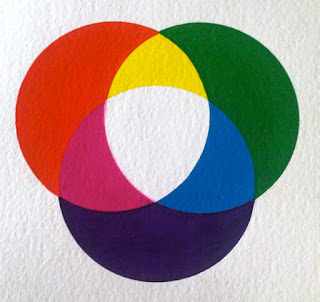 |
| Additive Primary Colors |
..and the Subtractive Primary Colors: Cyan, Magenta, and Yellow, that when mixed in equal parts, as all the light is subtracted, they make black. Subtractive color mixing is more complex than the additive color mixing you get with colored spotlights (as seen in the image above).
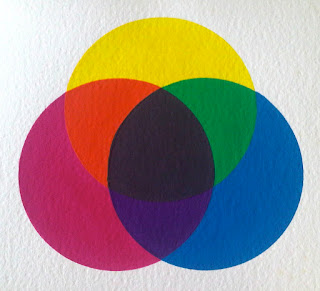 |
| Subtractive Primary Colors |
This was only the beginning of an enlightening class for me, as I learned to actually SEE color, by mixing the subtractive primaries: Cyan, Magenta and Yellow in different proportions, using eyedroppers to control the amount of pigment in each mixture.
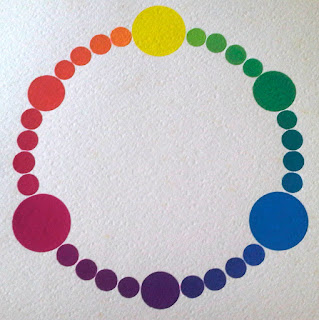 |
| One of the many color exercises I did during the Color class |
We also combined the resulted colors with black, or white or with the gray scale (by mixing white and black in different proportions to go from white to black). And learned that, when colors are combined with white or black we create tints (lighter tones) and shades (darker hues) of these colors.
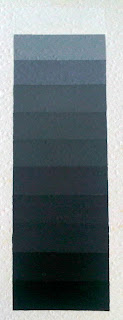 |
| Grey Scale |
This tedious exercises of mixing colors, over and over again, drop by drop, sharpened the way I see colors now. It actually made me aware of the colors within a color. So I really recommend this kind of exercises if you're an artists, painter, designer, or decorator... Take some time to learn to see color, and the best way is by practicing mixing colors together by hand and experience for yourself the changes in a color when adding a few drops of another color and so forth.
~~~*~~~
Just recently, one of my good friends had a bunch of paint color swatches and challenged me to work with them for the fun of it. I immediately jumped to the opportunity. I picked three swatches with different shades of grays. One was black and white with a hint of blue, the other one had a hint of green and the third one had a hint of red. My friend suggested to create curvy lines overlapping each other on a piece of paper. The challenge was to try to mimic the colors picked from the swatches, as each one should have a different color value.
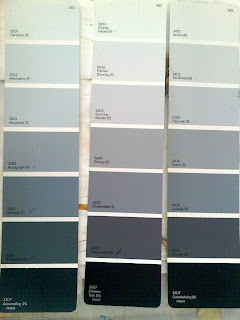 |
Here are the three swatches I chose
(I checked the values I used for you to see) |
I worked with Acrylic paint on paper, and my palette included Payne's Grey, Mars Black, Ivory Black, Titanium White, Hookers Green and Cadmium Red Hue.
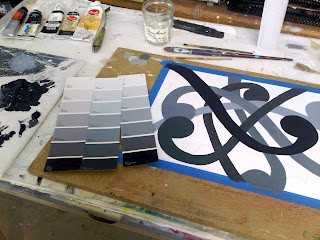 |
My working table.
I made zen-doodle like lines with spirals inside. |
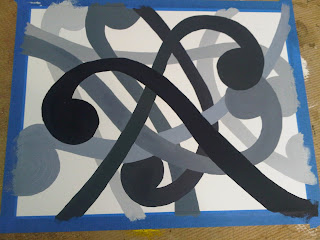 |
| Finished painting my greys. |
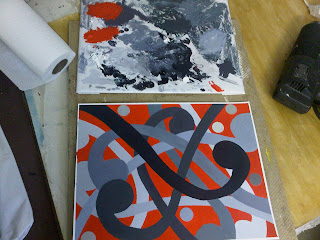 |
Added a contrasting color to the background
using the Cadmium Red Hue,
that was also used in some of my gray hues... and of course
my circles had to show up too, so I glued a few
swatches circles here and there! |
The final product resulted too flat for me, so I then went ahead and shaded the lines to add dimension to the painting by using graphite, charcoal, and a Stabilo's Aquarellable pencil in black (got a love those pencils)
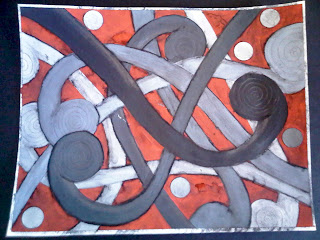 |
| A little bit of water and voila! |
... but still looked too flat to me, so I detached the dried paint from my palette carefully and glued it to areas of the painting. This gave it the effect of actually having splashed some of the paint on top of the painting, giving it a 3-D effect.
What I like about this process is that there, in the palette, are all of the shades as I was mixing the colors together, mimicking the mesh like design. So it adds an extra layer to capture the eye of the viewer.
To finish it up, I glued the painting to foam core and overlapped it to another piece of foam core that I had previously cover with grey-wash pages from an old encyclopedia.
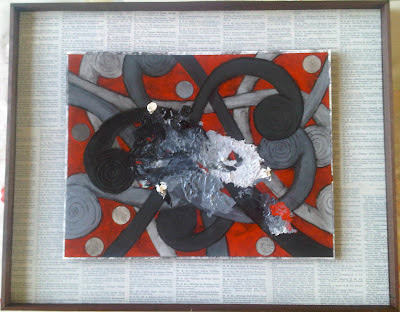 |
IT'S COMPLICATED!
15.5 x 19.5 inches
mixed media on paper
(c) Corina S. Alvarezdelugo | |
|
I really enjoyed going back to color basics with this exercise, and I'm sure you will too! So try it and share with me your results...
In the meantime, I invite you to take this fun and interesting
ONLINE COLOR CHALLENGE. Enjoy!










Sounds like an interesting color exercise--and I like the way your piece turned out, with a lot of texture!
ReplyDeleteThank you so much Deborah.
DeleteBTW, I love what you do with tea bags!! I love using them too! ;) I read they use Abaca pulp to make them, which is a strong fiber from a banana tree from the Philippines.
If you're interested more about it, I wrote about pulps before and you can read more here: http://corinadotdash.blogspot.com/2012/02/from-pulp-to-painting-all-way-to-dallas.html
Thanks again for your encouraging comments!!